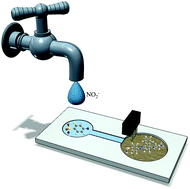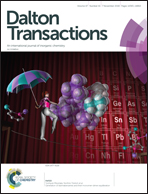Determination of nitrite ions in environment analysis with a paper-based microfluidic device†
Abstract
A new microfluidic paper-based analytical device, a (Ag-μPAD)-based chemiresistor composed of silver ink, has been developed for the selective, sensitive, and quantitative determination of nitrite ions in environmental analysis. The silver ink acts as an efficient transducer in terms of resistance changes due to nitrite initiating a diazo reaction and further reacting with the ink. The silver ink is synthesized onto the μPADs by pulsed light sintering from silver nanoparticles, a mixture of silver nanowires and nanoparticles. The resistance changes show two linear response ranges to nitrite in the concentration ranges of 1.0 × 10−8 M to 5.0 × 10−6 M and 1.0 × 10−5 M to 3.2 × 10−3 M, with a limit of detection of 8.5 × 10−11 M (S/N = 3). The sensor displays a wider linear range, a lower detection limit, a higher stability, high selectivity, low-volume sampling, and disposability for nitrite with respect to other nanoparticle- and paper-based sensors. The characterization of silver ink was verified by SEM, EDS, and IR studies, and the sensing mechanism is discussed. In addition, this paper-based sensor has been successfully employed to determine the nitrite content in tap, river and lake water samples.



 Please wait while we load your content...
Please wait while we load your content...